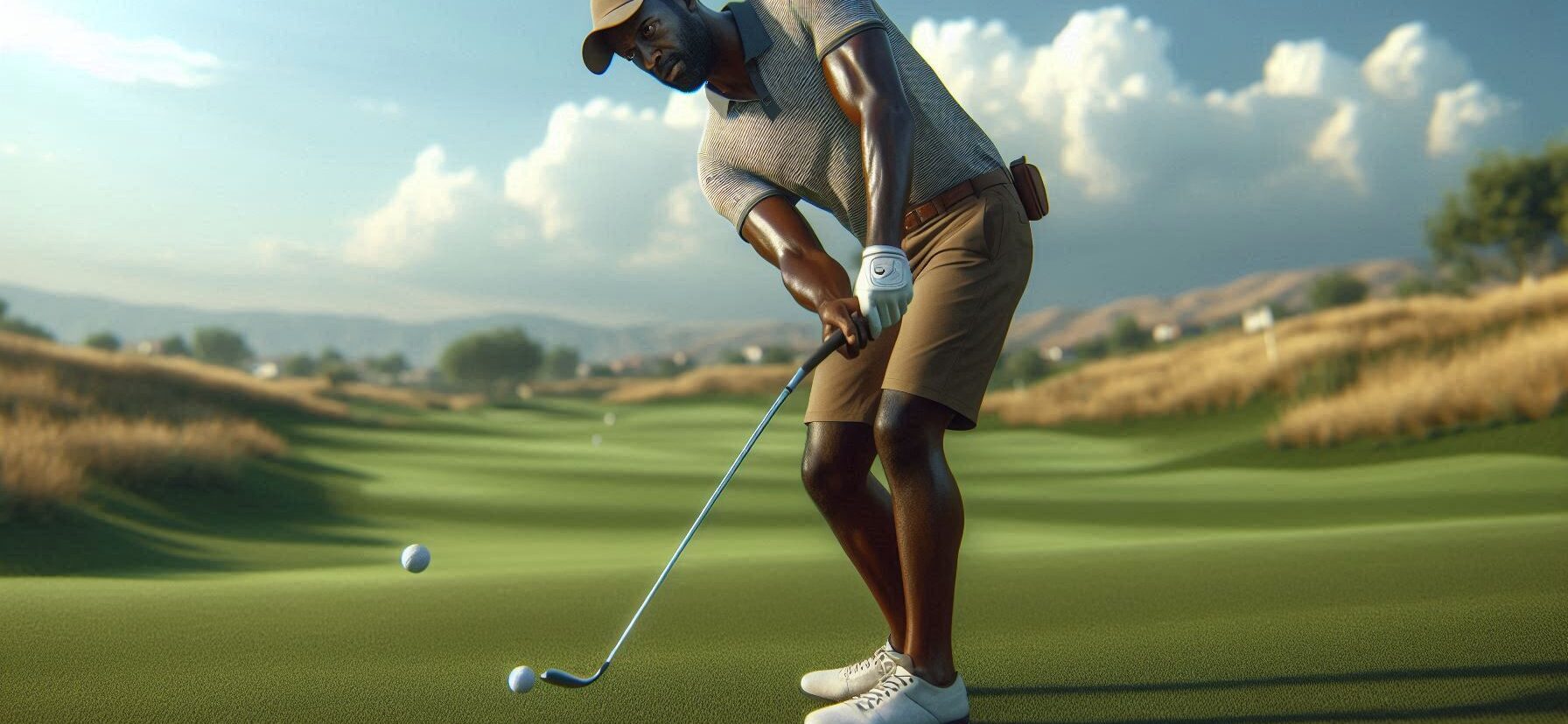Top Takeaways and Key Concepts
Please Note: This post may contain affiliate links. If you click one of them, we may receive a commission at no extra cost to you. As an Amazon Associate, I earn from qualifying purchases.
→ Focus on your follow-through to improve accuracy, distance, and overall shot consistency.
→ Maintain balance and stability throughout your swing for smoother, more controlled movement.
→ Engage hips and shoulders to create power and ensure a natural, full-body swing.
→ Keep arms extended after impact to maintain control and enhance shot direction.
→ Practice and visualize your finish to build confidence and reinforce proper muscle memory.
Summary of This Article
This article highlights how mastering your golf follow-through can transform your swing and overall performance. It explains the importance of balance, hip rotation, arm flow, and visualization to maintain rhythm and power. By focusing on a complete, fluid motion, golfers can improve control, consistency, and confidence with every shot.
Video Summary
Ah, the follow-up. It's like that secret ingredient in your favorite recipe that you didn't know you needed. People don't think about it much, much as no one pays attention to a cat at a dog show. But it truly does matter!
Have you ever seen those professional golfers? They swing and then finish with such style. It looks like they're dancing! You would assume they're doing ballet instead of merely trying to get a little ball into a hole far away. It looks very easy and smooth.
But here's the thing: doing your follow-through correctly might make all the difference. It could spell the difference between hitting the fairway and sending your ball on an unexpected trip into the trees. Wow, that's scary, right?
Let's take it apart a little. Your body needs to move through the shot when you swing, not just halt after hitting the ball. Picture yourself swinging through as if you're trying to grab something that is just out of reach. That helps keep everything in check and in balance.
Doing this over and over again can really improve your game go from “oops” to “wow!” So the next time you're out there, pay more attention to how you complete your swing. Do you feel that flow? It changes everything! With each swing, you'll get closer to hitting the ideal shot. Who knows? Maybe even a bird!
The Basics: What Is Follow-Through Anyway?

Let's talk about following through. It's not only saying goodbye to your golf ball as it sails away. This section of the swing is very crucial for both power and accuracy. When I initially started playing, I assumed my swing was over when I hit the ball. It's like giving someone a high-five and then leaving. Spoiler alert: that didn't go so well for me.
Your follow-through is like the last big bang of pyrotechnics. It should be fun! Your body needs to keep moving in a smooth arc after you strike the ball. Think about how scary it would be if you didn't stop suddenly like a squirrel on too much coffee. Keeping that flow going helps you stay in control and balanced.
It feels amazing when you finish your swing the right way. You'll see how much better your shots get. The ball goes farther and goes where you want it to go! Also, it feels incredibly good to finish strong.
Keep this in mind the next time you're on the course. Think of that follow-through as your chance to shine after making a terrific shot. Your game will be better for it! And who knows? Along the way, you might even impress some pals!
Balance: Finding Your Center
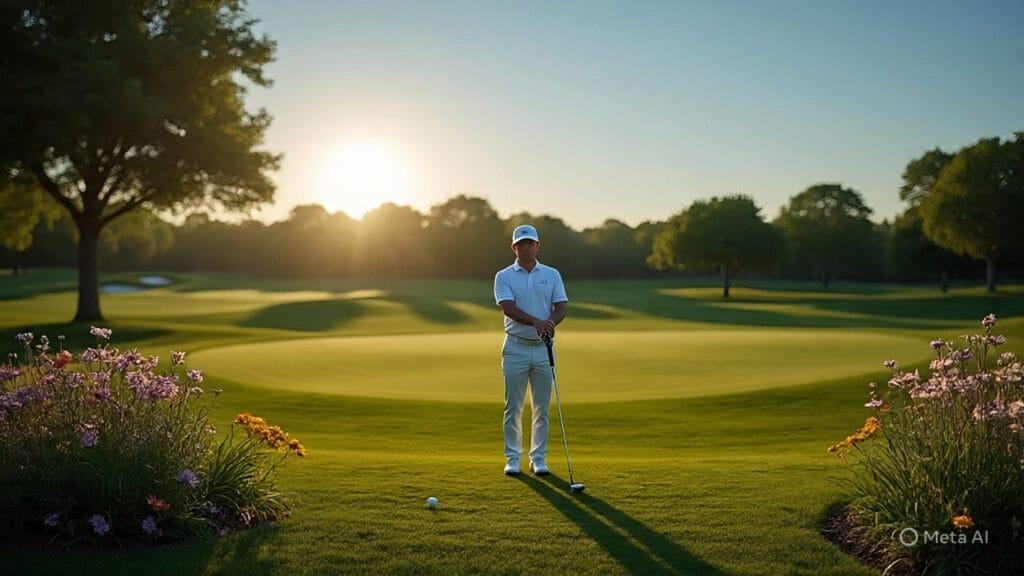
Let's talk about balance. It's very vital for a successful follow-through. Imagine trying to dance while hanging onto a chair that is not stable. It's not a good idea, is it? You'd probably fall over. Before you take that big swing at the ball, you need to be stable and grounded.
One day at the course, my friend Dave thought he could play like Tiger Woods without practicing very much. Oh my! Even the squirrels gave him strange looks as they ran by because he was so off balance. They must have been wondering, “What's wrong with that guy?”
It's evident what the lesson is here. How you stand and how you put your weight on your body are very important. If you're not balanced, your follow-through can look more like a crab walk than a smooth finish. We don't want that!
So, the next time you're out there, make sure to stand strong and steady before you swing. Make sure your weight is in the appropriate places and feel your feet on the ground. It will help you hit better shots and maybe even make the squirrels laugh instead of giving you dirty looks.
The Role of Hips and Shoulders

Let's get into those shoulder and hip movements. In “the perfect swing,” they're like the stars of the show. As you start your downswing, picture your hips leading the way. They should advance toward the objective while your shoulders follow along easily, like two pals supporting each other up a steep slope.
I remember when I finally got this right in one round. Wow, it felt great! I felt like I had learned some hidden ninja moves or something. My shots went farther than ever before, and my friends were left with their mouths wide. It was as if you could see them thinking, “What just happened?”
It was very funny! While I was feeling like a golf superhero, others were having a hard time behind me. Being able to shift your hips and shoulders can change everything. It really changes how far you hit the ball and how much enjoyment you have on the course. So go ahead and try it! You might surprise yourself, and your friends might even wonder what kind of magic you found!
Arm Positioning: Not Just for Show
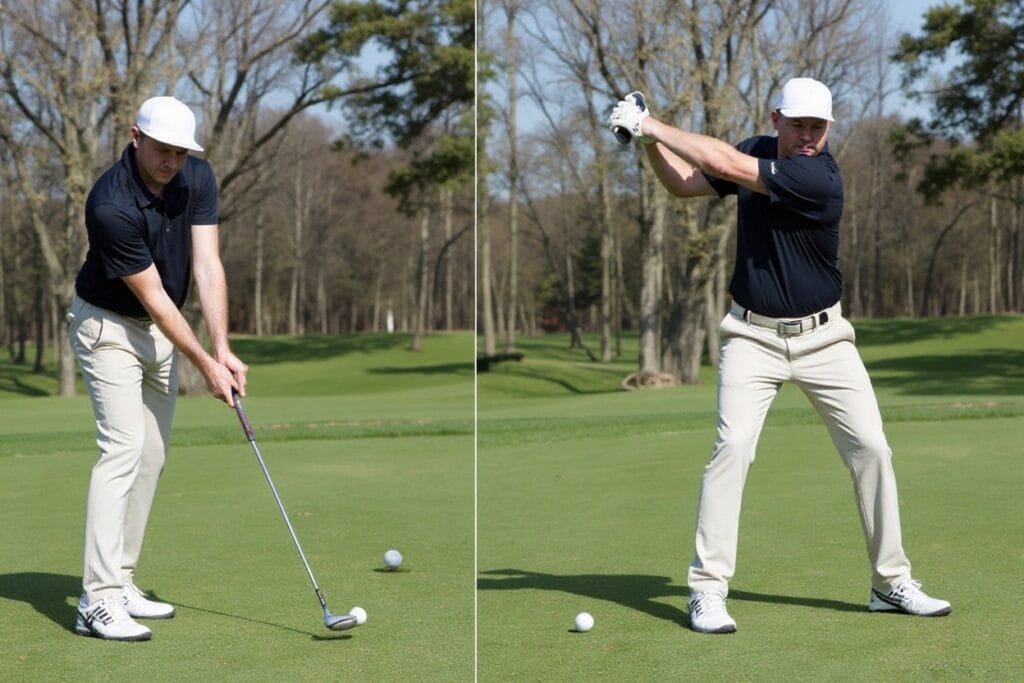
Here’s a fun fact: arm positioning really matters! Your arms should flow smoothly after you hit the ball. They shouldn’t clamp down like they’re scared of something biting them. That would definitely ruin anyone's day, right? Think about reaching out fully toward where you want that little white ball to go. No stopping mid-swing because you got distracted by thoughts of lunch or anything else.
I remember one time I swung super hard but totally forgot to extend my arms afterward. Oh boy, I nearly toppled over like Humpty Dumpty after his big fall! My friends were laughing so hard, I thought they might fall over too. It was kind of embarrassing but also hilarious.
That moment stuck with me. It showed me how important it is to keep those arms moving after contact. When your arms flow naturally, it helps with balance and makes your shots better too. So next time you're out there swinging away, just remember to let those arms follow through—no clamping down allowed! You’ll feel more in control and maybe even avoid a funny tumble or two!
Practicing Your Follow-Through
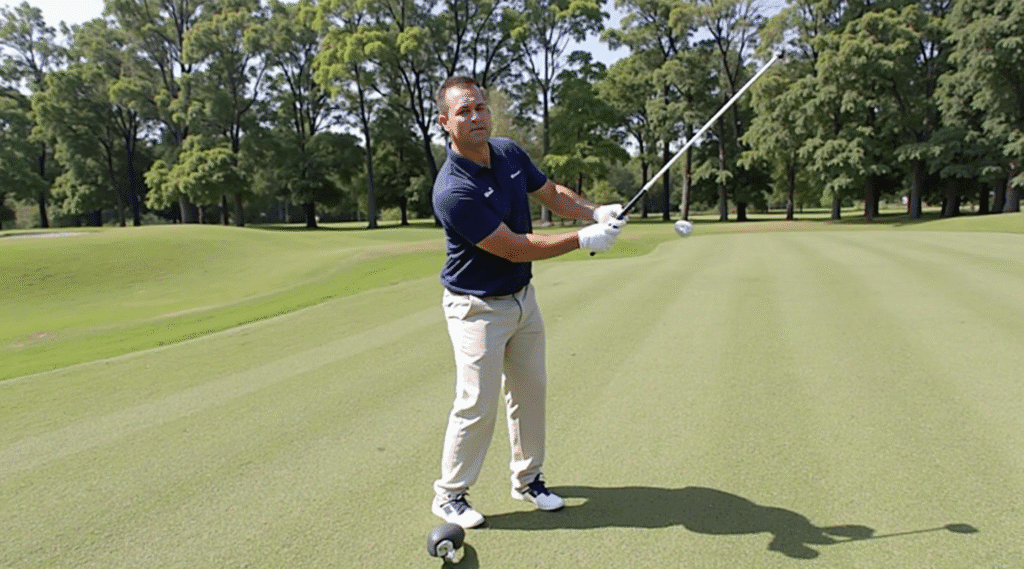
What can we do to improve our golf game? Well, practice makes perfect, or at least less humiliating! It really is about making time for this area of your game. Try swinging in slow motion. This helps you stay focused on finishing after you hit the ball. Hurrying through it like you're late for dinner won't help anyone (and we all know how stressful that can be!).
Here's a great idea: record yourself while you practice. You don't need to film in a fancy way or with high-tech gear. Simply use your phone! You can see what works and what doesn't by watching yourself. You might discover behaviors that need to be changed, such suddenly pulling back instead of forming the wonderful, fluid arcs we talked about earlier.
I remember the time I filmed myself. I thought it was silly at first, but then I realized my mistakes plainly. It opened my eyes! I realized that I wasn't finishing my swings as well as I thought I was. It helped me alter things up when I saw it.
It's quite good to practice this method for a while. It's like having a small coach next to you who tells you what to work on. And every time you practice, you're coming closer to those great shots that make everyone go “wow!” So pick up your club and give it a shot. You can do it!
Visualization Techniques: See It Before You Swing It
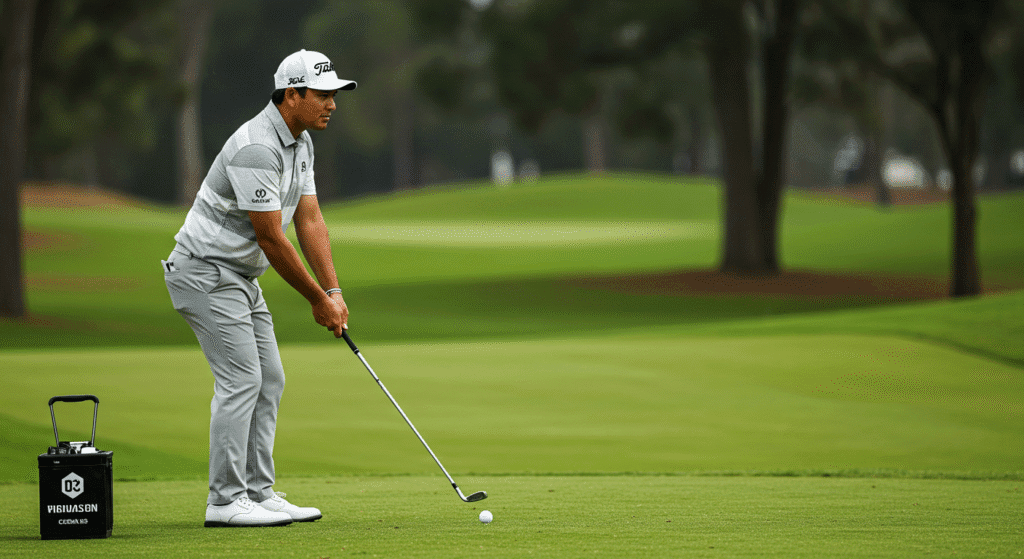
What a fantastic technique visualization is! It's like daydreaming about making flawless shots while drinking lemonade on a beach. You get the idea, even if it's not exactly that. Imagine yourself swinging gracefully, with all of your body parts functioning together perfectly. Think about how good it feels when everything comes together!
Imagining those perfect swings definitely helps your brain remember what to do later. Your muscles also start to learn. So even when you're angry, like when that ball travels the opposite way, you can still find some peace.
I remember being so furious when I missed an easy shot. I didn't allow it get to me. Instead, I closed my eyes and imagined myself making that perfect swing over and over again. It felt good! I could feel that recollection helping me stay focused the following time I played.
When you think about success, it helps you get rid of the clutter in your head. You'll feel more sure of yourself and ready to go when you go onto the greens again. Just try it. You might be amazed at how much it helps!
The Mental Game: Confidence Counts
Confidence is a big deal in golf. Seriously, if you start thinking, “What if I miss?” it can mess everything up. Your body might tense up like a stiff board. That’s not what we want when we’re trying to hit the ball far and straight!
When you practice, try telling yourself nice things. Simple stuff like, “I can do this!” or “I’m getting better every time.” It helps! Remember why you play golf—not just to beat your friends but to enjoy being outside and having fun with each swing.
I’ve had days when I felt unsure. My swings were all over the place. Then I started saying those positive things to myself. It changed everything! Suddenly, I felt lighter and more relaxed. Each shot became more about joy than pressure.
So go ahead and take that knowledge with you next time you're out there. Think about your follow-through and how strong it can be. You’ll surprise everyone around you—maybe even make them think you’ve got some magic skills! Just remember to breathe, smile, and enjoy the game. You got this!
Featured Snippet: A strong golf follow-through improves accuracy, distance, and consistency by ensuring balance, power, and full-body coordination. By focusing on smooth hip rotation, steady arm extension, and proper weight transfer, golfers can create cleaner, more controlled swings and boost both confidence and performance on every shot.
Frequently Asked Questions
Why is follow-through important in golf?
Follow-through ensures proper balance, power transfer, and accuracy, helping your shots stay consistent and controlled.
How can I improve my golf follow-through?
Practice slow, deliberate swings focusing on balance, hip rotation, and arm extension after impact.
What role do hips and shoulders play in follow-through?
Your hips lead the motion while your shoulders follow, creating natural power and smooth swing flow.
Why do I lose balance during my follow-through?
Losing balance often comes from poor weight distribution—keep your stance stable and shift weight forward naturally.
How can visualization help my follow-through?
Visualizing successful swings helps train your brain and body for confidence, rhythm, and precision on the course.
Should my arms stay extended after hitting the ball?
Yes, extending your arms through impact maintains control and improves distance and shot direction.
How often should I practice my follow-through?
Regular practice, even in slow motion, strengthens muscle memory and helps create a fluid, powerful swing finish.
Suggested Resources:
Mastering Golf Swing Mechanics
https://www.golf.com/swing-mechanics/
Improving Your Golf Game Through Visualization
https://www.golfdigest.com/story/visualization-techniques-in-golf
Understanding Balance in Golf
https://www.thegolfguide.com/balance-in-golf/
Golf Drills for Better Follow-Through
https://www.golflessons.com/followthrough-drills/

Kevin Collier is an avid golfer and contributing author at AIGolfTips.com, where he shares his passion for the game through expert tips, techniques, and gear reviews. With years of experience on the course, Kevin offers valuable insights for golfers of all skill levels, helping them improve their game and maximize their potential. Whether discussing swing mechanics or the latest in golf technology, Kevin's engaging approach aims to inspire and educate fellow golf enthusiasts to elevate their performance and enjoy every moment on the green.




